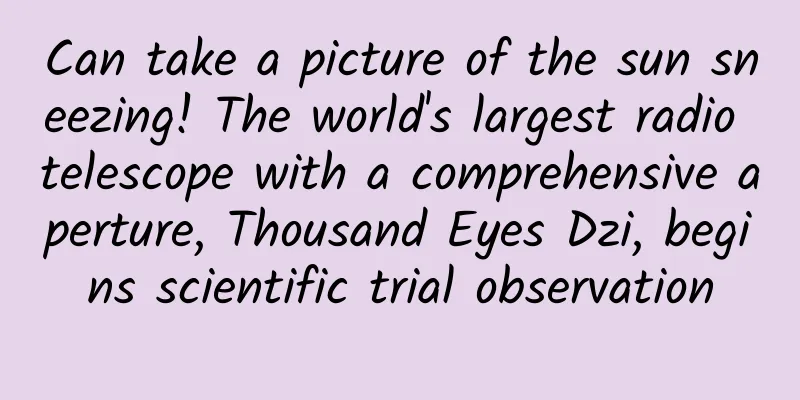Can take a picture of the sun sneezing! The world's largest radio telescope with a comprehensive aperture, Thousand Eyes Dzi, begins scientific trial observation

|
On July 14, the circular array solar radio imaging telescope developed by the National Space Science Center of the Chinese Academy of Sciences, after half a year of debugging and testing, now has the ability to continuously, stably and with high quality monitor solar activity. Radio astronomical observation capabilities such as pulsar imaging have been preliminarily verified, and scientific trial observations have officially started. Image source: National Space Science Center, Chinese Academy of Sciences The circular array solar radio imaging telescope located in Daocheng, Sichuan, is like a string of pearls inlaid on the plateau. It is also called "Thousand Eyes Dzi Beads" and is a landmark equipment of the second phase of the National Major Science and Technology Infrastructure Meridian Project. "Thousand Eyes Dzi Beads" consists of 313 unit antennas and is currently the world's largest radio telescope with a comprehensive aperture. Thousand-eyed Dzi Beads Can take a picture of the sun "sneezing" The Meridian Project is an observation network planned by the state for studying space weather. As a major scientific and technological infrastructure in my country, the Meridian Project Phase I was put into operation in 2012, and Phase II started in 2019 and is expected to be fully completed by the end of this year. The Circular Array Solar Radio Imaging Telescope is one of the landmark equipment of Phase II of the Meridian Project. The core mission of the Torus Array Solar Radio Imaging Telescope is to monitor the source of space weather events on Earth in real time - the Sun. The Sun is the closest star to us, bringing light and heat to the Earth and humans, and nurturing life on Earth, but it also has its "sneezes". A strong solar eruption will release the energy of 10 billion million-ton atomic bombs. If the charged particles ejected during the eruption fly toward the Earth, the huge energy carried by the plasma group will have a serious impact on the Earth, causing damage to Earth-orbiting satellites, etc. The "sky-observing artifact" stares at the sun every day to see when it "sneezes" and the direction and speed of its "sneezes". It can provide space weather warnings for the normal operation of satellites and other facilities and ensure the safe operation of various equipment. Detection targets and spatial range distribution of the solar-interplanetary subsystem Image source: National Space Science Center, Chinese Academy of Sciences Humans have a long history of observing the sun, and they have a variety of means. Not only do we have high-energy X-ray, ultraviolet and visible light observations on satellites, but we also have visible light, infrared, millimeter wave and radio telescopes on the ground. However, the observation capabilities in the low-frequency band are lacking. For example, the 150-450MHz band can only be observed by a telescope built in France in the 1980s, and its sensitivity and resolution are far from meeting the needs. In addition, because the earth is rotating, this radio telescope cannot observe the sun continuously and cannot meet the requirements of observation time zone coverage. The Torus Solar Radio Imaging Telescope fills this gap. It can observe the radio radiation generated by solar flares and coronal mass ejections, synthesize continuous videos through radio image sequences, monitor the formation and evolution of these substances ejected from the sun, study the process and mechanism of solar eruptions, and determine the speed and direction of coronal mass ejections. This can help scientists study the laws and mechanisms of solar eruptions, analyze whether and when coronal mass will reach the earth, and predict whether space weather events will occur. The circular array solar radio imaging telescope under construction Image source: National Space Science Center, Chinese Academy of Sciences Comprehensive sources: Science and Technology Daily, CCTV News, National Space Science Center of the Chinese Academy of Sciences, etc. |
<<: Is it necessary to apply sunscreen even on cloudy days?
Recommend
Soul Product Analysis Report
Soul was launched in 2016 and quickly captured th...
Does skipping breakfast help you lose weight? The more vitamin C you take, the better? Here are the scientific rumors for February
1. The number of fever cases has soared recently,...
What exactly is “Ice No. 7”?
Since the news that people can wear short sleeves...
Sony Z3 may be able to dive to a depth of 2 meters, its waterproof performance is considered "abnormal"
Recently, Sony officially released several "...
Lighthouse SEO Training: What optimizations should be made to the website domain name for corporate website promotion?
The user's first impression of a website is t...
National Defense Science Popularization Gas Station (36) Supercontinuum Laser: An Extraordinary New Light Source
In the field of optics, laser has the characteris...
The joint management of mountains, rivers, forests, fields, lakes, grasslands and sands aims to weave a beautiful coat for the earth
Some people say that deserts and desertified land...
High retention methods for acquiring customers by e-commerce platforms such as Pinduoduo!
Speaking of social games, most people may think o...
What are the functions of Foshan lawyer mini program development and how much does it cost to develop a lawyer legal consultation mini program?
Recently a friend consulted me and wanted to make...
Sichuan Xunniu March Chan Theory Basic Course
Introduction to the resources of the March Chaos ...
A 1-year-old girl was poisoned by a rare and severe poison. Be careful! 1g can be fatal, and there is no specific medicine...
Thallium is a rare heavy metal Usually in profess...
BYD launches 3 billion yuan education charity fund to promote scientific and educational progress in China
On December 30, BYD held a launching ceremony for...
You must have tried this "strongest peripheral" of "Man Jiang Hong"!
This year's Spring Festival movie "Man J...
Internet TV is the mainstream and traditional strategies have no future
In the past, the development of the entire color ...
A comprehensive review of the top ten most classic interactive marketing cases!
Today, I will take you to review the top ten inte...









